Pearson BTEC Level 4 HNC Health and Social Care: Influences Report
VerifiedAdded on 2020/06/05
|11
|3317
|79
Report
AI Summary
This report delves into the multifaceted influences affecting health and social care organizations, examining the impact of external environmental factors, organizational structures, and leadership styles. The report begins by analyzing the external environment's influence, followed by an evaluation of how organizations respond to these factors, including stakeholder considerations. It then compares and contrasts various organizational structures within the health and social care sector, and analyzes the concept of organizational culture and its impact on service delivery. The report further examines theories of individual and group behavior and their relevance within these organizations. Finally, it explores leadership concepts, different leadership styles, and their influence on the effectiveness of health and social care services, providing insights into how effective leadership contributes to improved outcomes. The report uses Voluntary Service Overseas (VSO) as a case study.
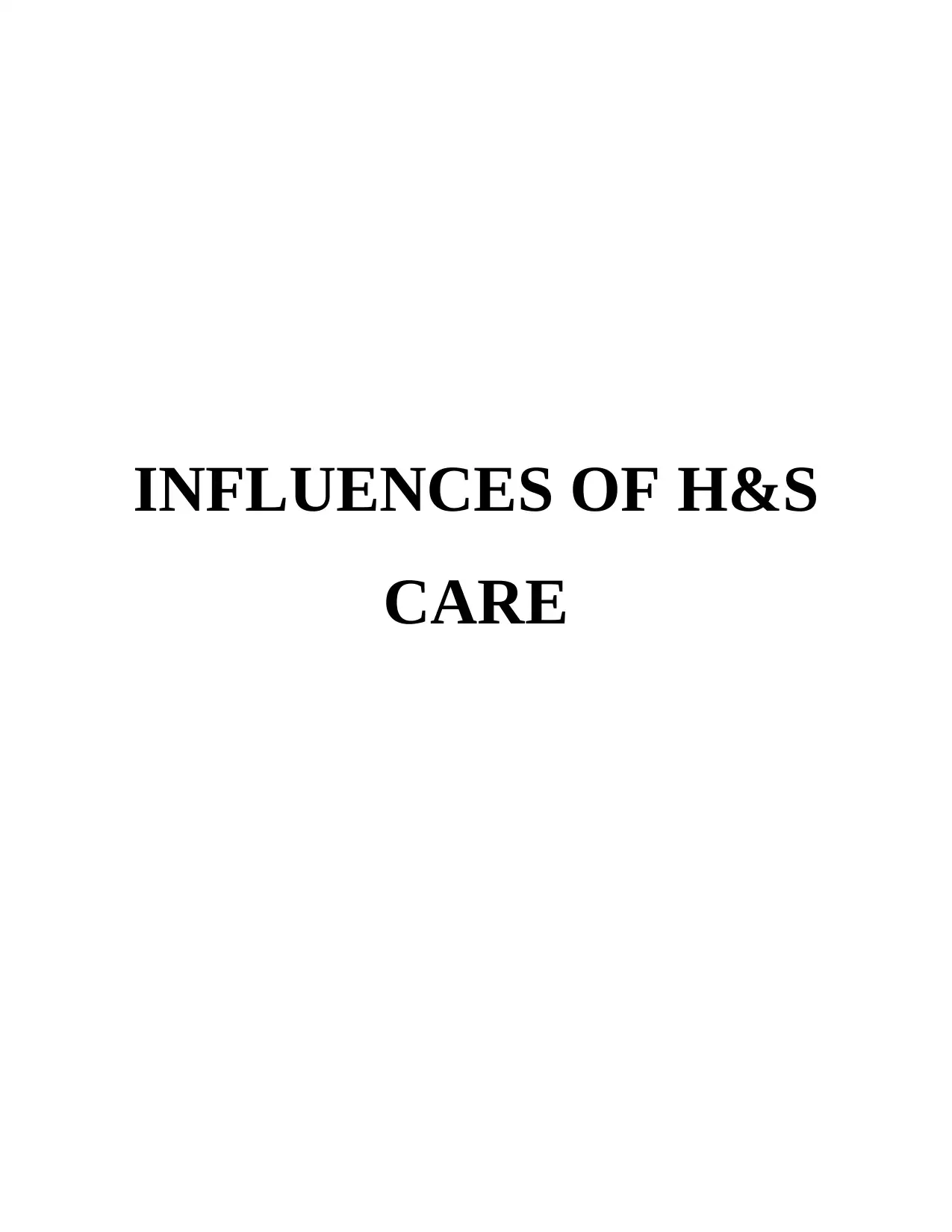
INFLUENCES OF H&S
CARE
CARE
Paraphrase This Document
Need a fresh take? Get an instant paraphrase of this document with our AI Paraphraser
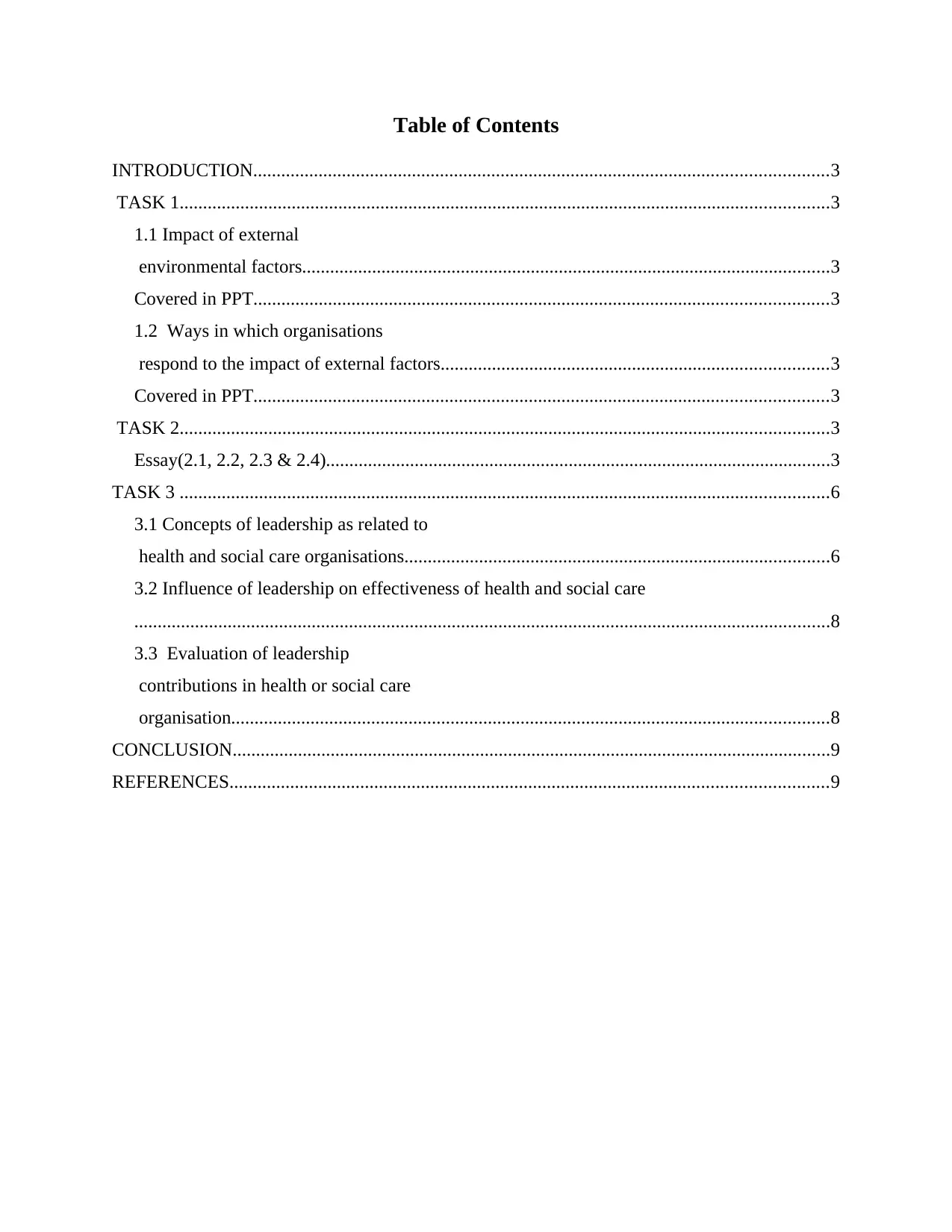
Table of Contents
INTRODUCTION...........................................................................................................................3
TASK 1...........................................................................................................................................3
1.1 Impact of external
environmental factors.................................................................................................................3
Covered in PPT...........................................................................................................................3
1.2 Ways in which organisations
respond to the impact of external factors...................................................................................3
Covered in PPT...........................................................................................................................3
TASK 2...........................................................................................................................................3
Essay(2.1, 2.2, 2.3 & 2.4)............................................................................................................3
TASK 3 ...........................................................................................................................................6
3.1 Concepts of leadership as related to
health and social care organisations...........................................................................................6
3.2 Influence of leadership on effectiveness of health and social care
.....................................................................................................................................................8
3.3 Evaluation of leadership
contributions in health or social care
organisation................................................................................................................................8
CONCLUSION................................................................................................................................9
REFERENCES................................................................................................................................9
INTRODUCTION...........................................................................................................................3
TASK 1...........................................................................................................................................3
1.1 Impact of external
environmental factors.................................................................................................................3
Covered in PPT...........................................................................................................................3
1.2 Ways in which organisations
respond to the impact of external factors...................................................................................3
Covered in PPT...........................................................................................................................3
TASK 2...........................................................................................................................................3
Essay(2.1, 2.2, 2.3 & 2.4)............................................................................................................3
TASK 3 ...........................................................................................................................................6
3.1 Concepts of leadership as related to
health and social care organisations...........................................................................................6
3.2 Influence of leadership on effectiveness of health and social care
.....................................................................................................................................................8
3.3 Evaluation of leadership
contributions in health or social care
organisation................................................................................................................................8
CONCLUSION................................................................................................................................9
REFERENCES................................................................................................................................9
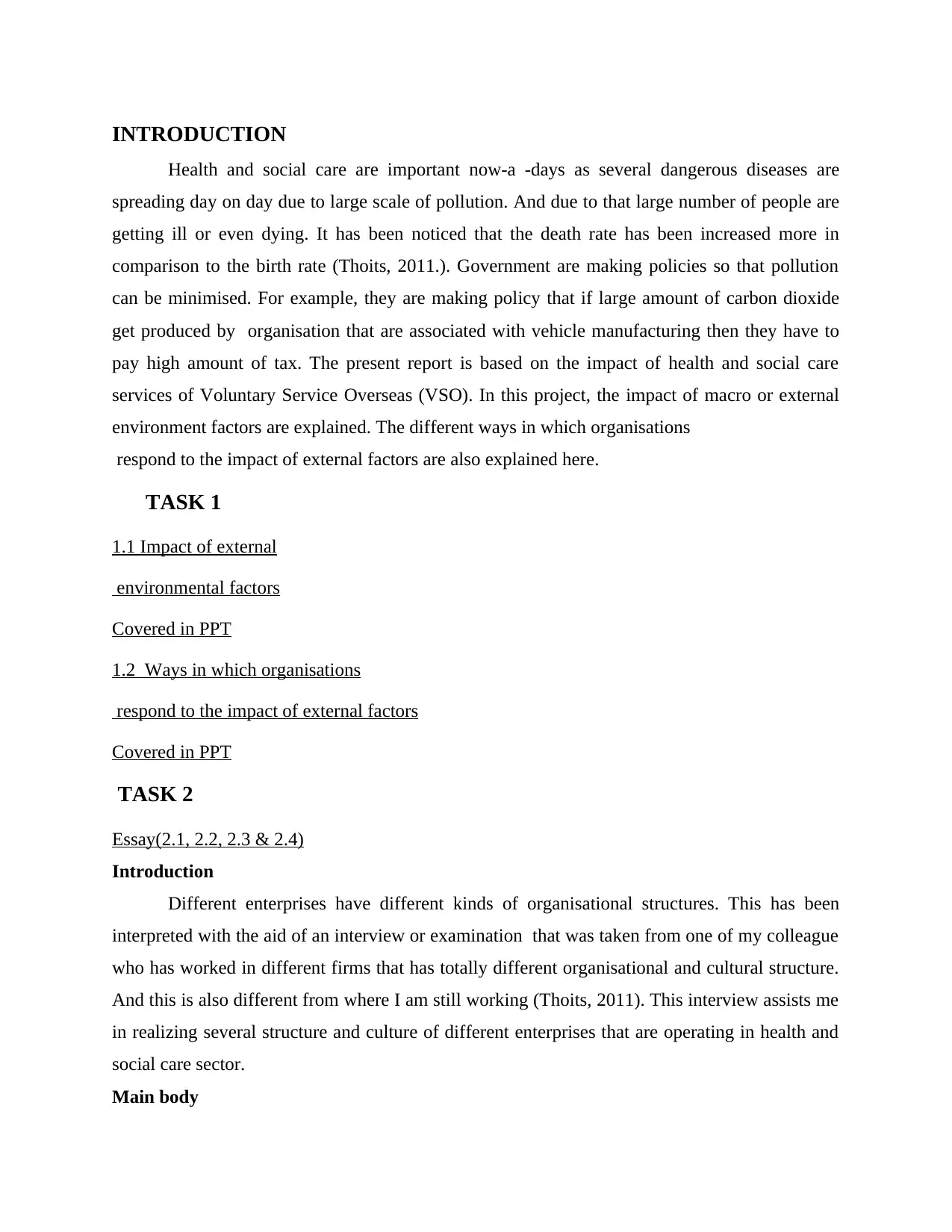
INTRODUCTION
Health and social care are important now-a -days as several dangerous diseases are
spreading day on day due to large scale of pollution. And due to that large number of people are
getting ill or even dying. It has been noticed that the death rate has been increased more in
comparison to the birth rate (Thoits, 2011.). Government are making policies so that pollution
can be minimised. For example, they are making policy that if large amount of carbon dioxide
get produced by organisation that are associated with vehicle manufacturing then they have to
pay high amount of tax. The present report is based on the impact of health and social care
services of Voluntary Service Overseas (VSO). In this project, the impact of macro or external
environment factors are explained. The different ways in which organisations
respond to the impact of external factors are also explained here.
TASK 1
1.1 Impact of external
environmental factors
Covered in PPT
1.2 Ways in which organisations
respond to the impact of external factors
Covered in PPT
TASK 2
Essay(2.1, 2.2, 2.3 & 2.4)
Introduction
Different enterprises have different kinds of organisational structures. This has been
interpreted with the aid of an interview or examination that was taken from one of my colleague
who has worked in different firms that has totally different organisational and cultural structure.
And this is also different from where I am still working (Thoits, 2011). This interview assists me
in realizing several structure and culture of different enterprises that are operating in health and
social care sector.
Main body
Health and social care are important now-a -days as several dangerous diseases are
spreading day on day due to large scale of pollution. And due to that large number of people are
getting ill or even dying. It has been noticed that the death rate has been increased more in
comparison to the birth rate (Thoits, 2011.). Government are making policies so that pollution
can be minimised. For example, they are making policy that if large amount of carbon dioxide
get produced by organisation that are associated with vehicle manufacturing then they have to
pay high amount of tax. The present report is based on the impact of health and social care
services of Voluntary Service Overseas (VSO). In this project, the impact of macro or external
environment factors are explained. The different ways in which organisations
respond to the impact of external factors are also explained here.
TASK 1
1.1 Impact of external
environmental factors
Covered in PPT
1.2 Ways in which organisations
respond to the impact of external factors
Covered in PPT
TASK 2
Essay(2.1, 2.2, 2.3 & 2.4)
Introduction
Different enterprises have different kinds of organisational structures. This has been
interpreted with the aid of an interview or examination that was taken from one of my colleague
who has worked in different firms that has totally different organisational and cultural structure.
And this is also different from where I am still working (Thoits, 2011). This interview assists me
in realizing several structure and culture of different enterprises that are operating in health and
social care sector.
Main body
⊘ This is a preview!⊘
Do you want full access?
Subscribe today to unlock all pages.

Trusted by 1+ million students worldwide
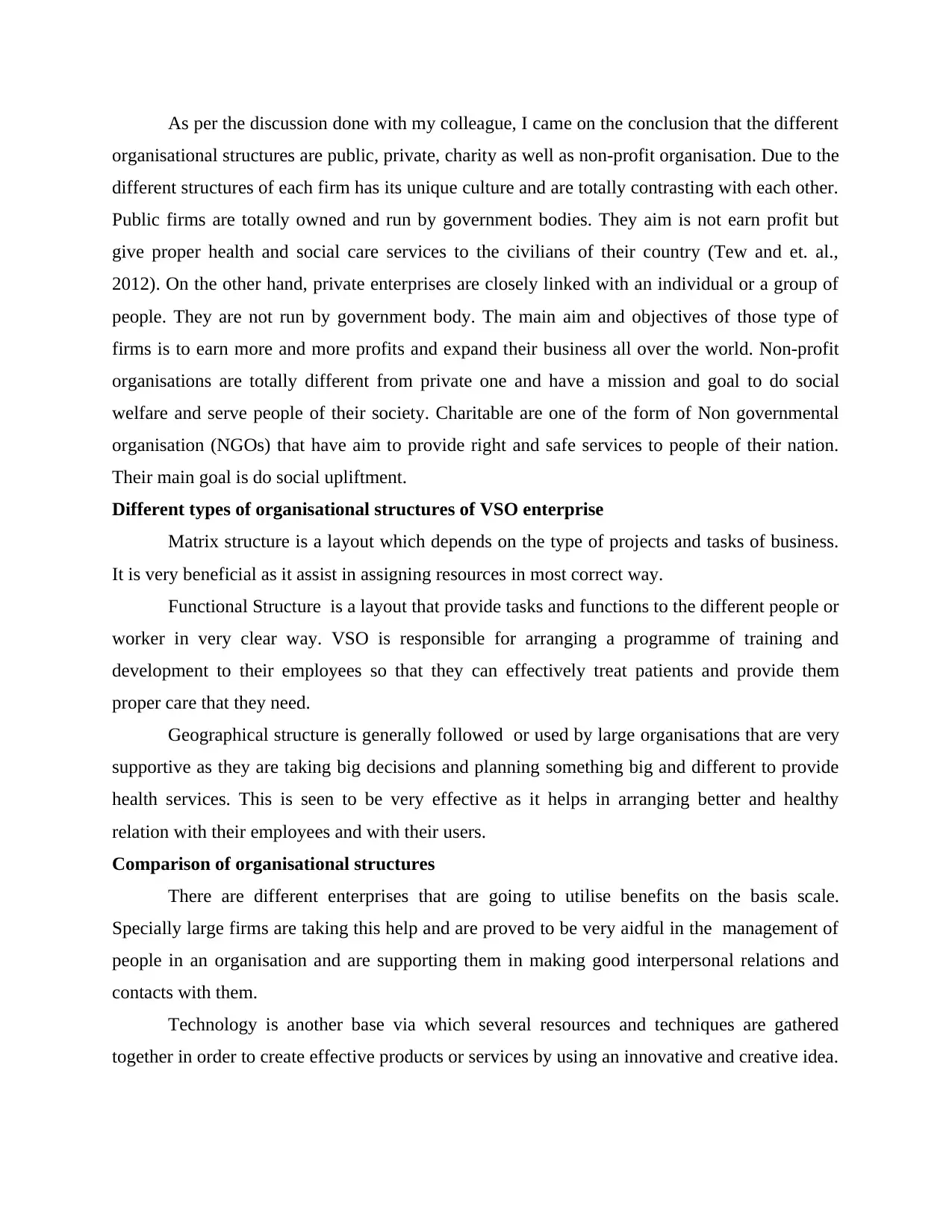
As per the discussion done with my colleague, I came on the conclusion that the different
organisational structures are public, private, charity as well as non-profit organisation. Due to the
different structures of each firm has its unique culture and are totally contrasting with each other.
Public firms are totally owned and run by government bodies. They aim is not earn profit but
give proper health and social care services to the civilians of their country (Tew and et. al.,
2012). On the other hand, private enterprises are closely linked with an individual or a group of
people. They are not run by government body. The main aim and objectives of those type of
firms is to earn more and more profits and expand their business all over the world. Non-profit
organisations are totally different from private one and have a mission and goal to do social
welfare and serve people of their society. Charitable are one of the form of Non governmental
organisation (NGOs) that have aim to provide right and safe services to people of their nation.
Their main goal is do social upliftment.
Different types of organisational structures of VSO enterprise
Matrix structure is a layout which depends on the type of projects and tasks of business.
It is very beneficial as it assist in assigning resources in most correct way.
Functional Structure is a layout that provide tasks and functions to the different people or
worker in very clear way. VSO is responsible for arranging a programme of training and
development to their employees so that they can effectively treat patients and provide them
proper care that they need.
Geographical structure is generally followed or used by large organisations that are very
supportive as they are taking big decisions and planning something big and different to provide
health services. This is seen to be very effective as it helps in arranging better and healthy
relation with their employees and with their users.
Comparison of organisational structures
There are different enterprises that are going to utilise benefits on the basis scale.
Specially large firms are taking this help and are proved to be very aidful in the management of
people in an organisation and are supporting them in making good interpersonal relations and
contacts with them.
Technology is another base via which several resources and techniques are gathered
together in order to create effective products or services by using an innovative and creative idea.
organisational structures are public, private, charity as well as non-profit organisation. Due to the
different structures of each firm has its unique culture and are totally contrasting with each other.
Public firms are totally owned and run by government bodies. They aim is not earn profit but
give proper health and social care services to the civilians of their country (Tew and et. al.,
2012). On the other hand, private enterprises are closely linked with an individual or a group of
people. They are not run by government body. The main aim and objectives of those type of
firms is to earn more and more profits and expand their business all over the world. Non-profit
organisations are totally different from private one and have a mission and goal to do social
welfare and serve people of their society. Charitable are one of the form of Non governmental
organisation (NGOs) that have aim to provide right and safe services to people of their nation.
Their main goal is do social upliftment.
Different types of organisational structures of VSO enterprise
Matrix structure is a layout which depends on the type of projects and tasks of business.
It is very beneficial as it assist in assigning resources in most correct way.
Functional Structure is a layout that provide tasks and functions to the different people or
worker in very clear way. VSO is responsible for arranging a programme of training and
development to their employees so that they can effectively treat patients and provide them
proper care that they need.
Geographical structure is generally followed or used by large organisations that are very
supportive as they are taking big decisions and planning something big and different to provide
health services. This is seen to be very effective as it helps in arranging better and healthy
relation with their employees and with their users.
Comparison of organisational structures
There are different enterprises that are going to utilise benefits on the basis scale.
Specially large firms are taking this help and are proved to be very aidful in the management of
people in an organisation and are supporting them in making good interpersonal relations and
contacts with them.
Technology is another base via which several resources and techniques are gathered
together in order to create effective products or services by using an innovative and creative idea.
Paraphrase This Document
Need a fresh take? Get an instant paraphrase of this document with our AI Paraphraser
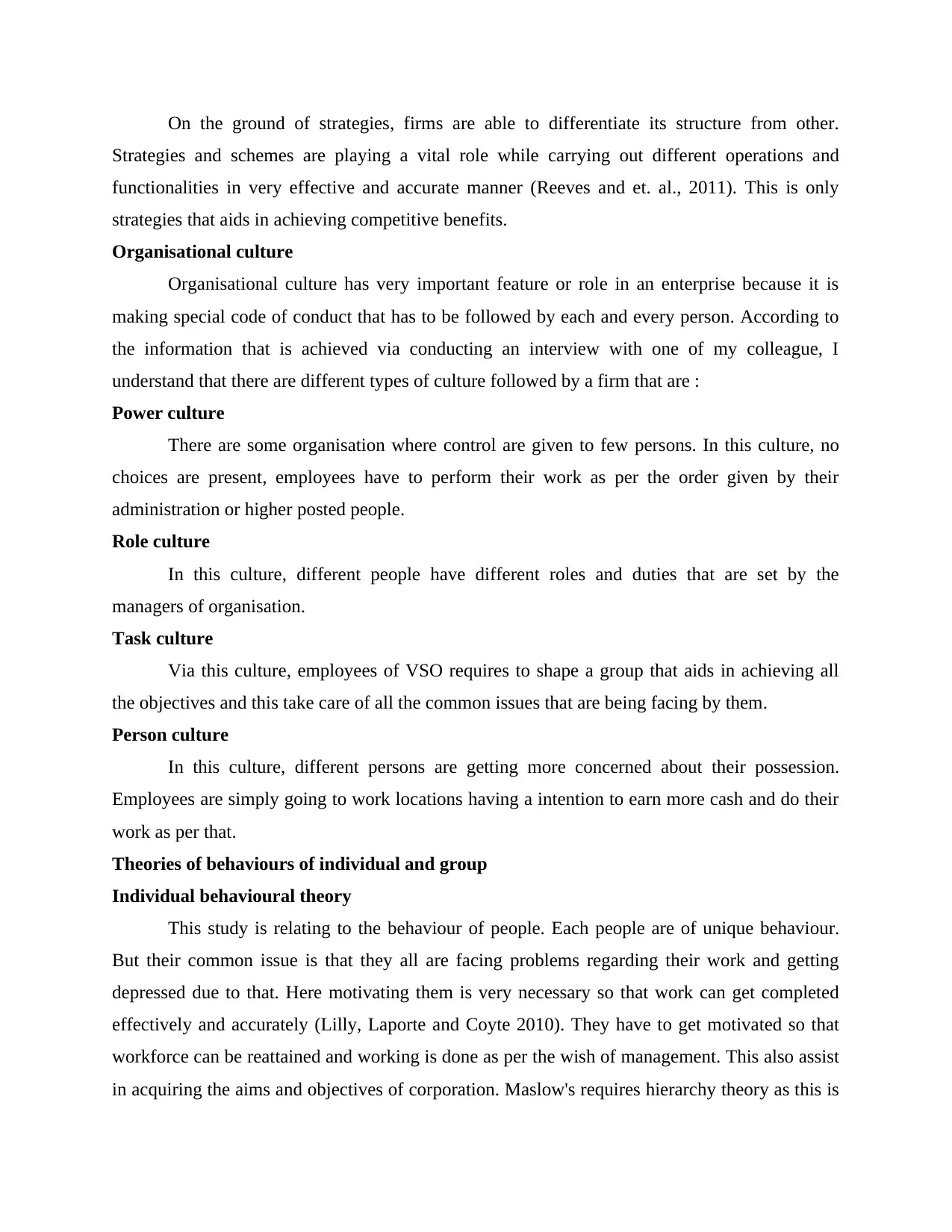
On the ground of strategies, firms are able to differentiate its structure from other.
Strategies and schemes are playing a vital role while carrying out different operations and
functionalities in very effective and accurate manner (Reeves and et. al., 2011). This is only
strategies that aids in achieving competitive benefits.
Organisational culture
Organisational culture has very important feature or role in an enterprise because it is
making special code of conduct that has to be followed by each and every person. According to
the information that is achieved via conducting an interview with one of my colleague, I
understand that there are different types of culture followed by a firm that are :
Power culture
There are some organisation where control are given to few persons. In this culture, no
choices are present, employees have to perform their work as per the order given by their
administration or higher posted people.
Role culture
In this culture, different people have different roles and duties that are set by the
managers of organisation.
Task culture
Via this culture, employees of VSO requires to shape a group that aids in achieving all
the objectives and this take care of all the common issues that are being facing by them.
Person culture
In this culture, different persons are getting more concerned about their possession.
Employees are simply going to work locations having a intention to earn more cash and do their
work as per that.
Theories of behaviours of individual and group
Individual behavioural theory
This study is relating to the behaviour of people. Each people are of unique behaviour.
But their common issue is that they all are facing problems regarding their work and getting
depressed due to that. Here motivating them is very necessary so that work can get completed
effectively and accurately (Lilly, Laporte and Coyte 2010). They have to get motivated so that
workforce can be reattained and working is done as per the wish of management. This also assist
in acquiring the aims and objectives of corporation. Maslow's requires hierarchy theory as this is
Strategies and schemes are playing a vital role while carrying out different operations and
functionalities in very effective and accurate manner (Reeves and et. al., 2011). This is only
strategies that aids in achieving competitive benefits.
Organisational culture
Organisational culture has very important feature or role in an enterprise because it is
making special code of conduct that has to be followed by each and every person. According to
the information that is achieved via conducting an interview with one of my colleague, I
understand that there are different types of culture followed by a firm that are :
Power culture
There are some organisation where control are given to few persons. In this culture, no
choices are present, employees have to perform their work as per the order given by their
administration or higher posted people.
Role culture
In this culture, different people have different roles and duties that are set by the
managers of organisation.
Task culture
Via this culture, employees of VSO requires to shape a group that aids in achieving all
the objectives and this take care of all the common issues that are being facing by them.
Person culture
In this culture, different persons are getting more concerned about their possession.
Employees are simply going to work locations having a intention to earn more cash and do their
work as per that.
Theories of behaviours of individual and group
Individual behavioural theory
This study is relating to the behaviour of people. Each people are of unique behaviour.
But their common issue is that they all are facing problems regarding their work and getting
depressed due to that. Here motivating them is very necessary so that work can get completed
effectively and accurately (Lilly, Laporte and Coyte 2010). They have to get motivated so that
workforce can be reattained and working is done as per the wish of management. This also assist
in acquiring the aims and objectives of corporation. Maslow's requires hierarchy theory as this is
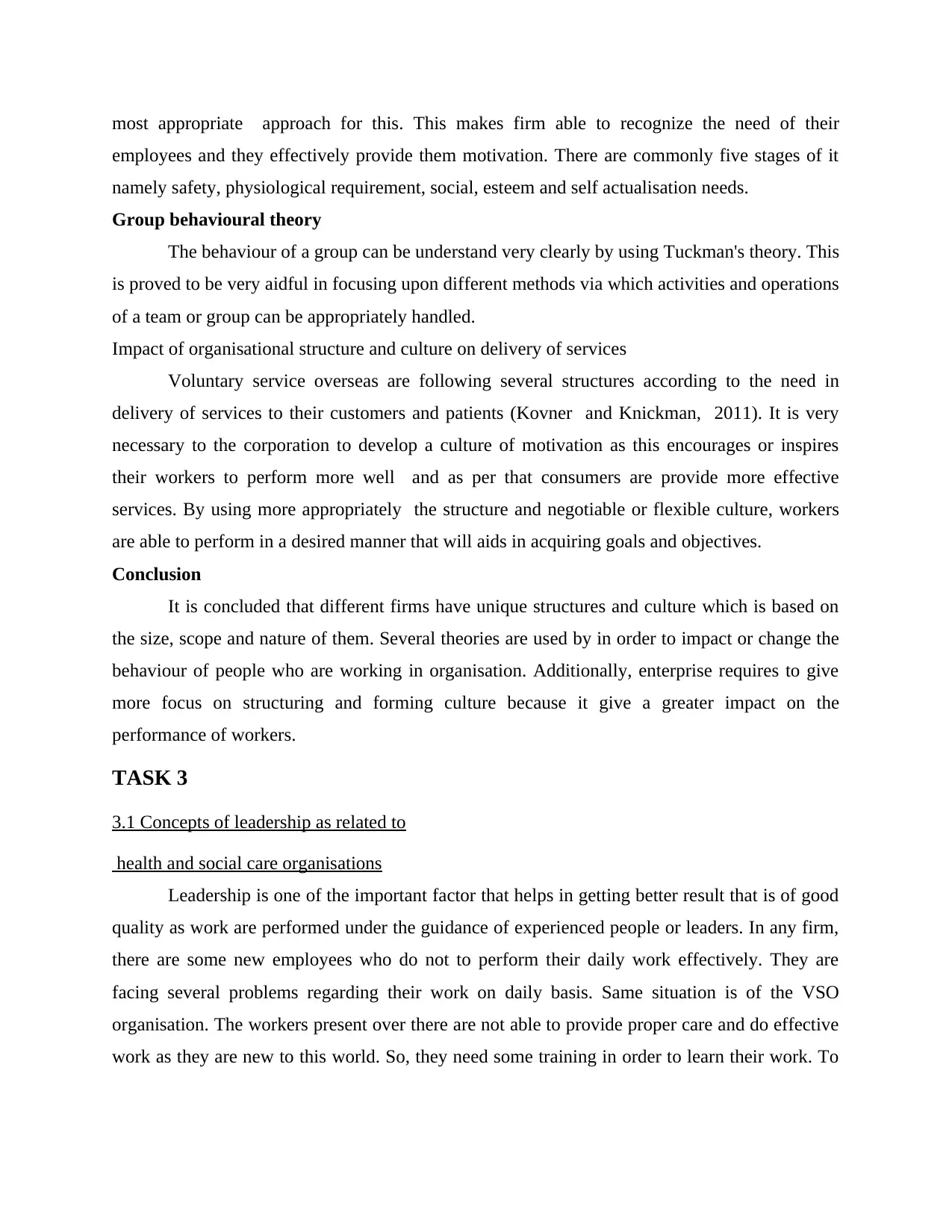
most appropriate approach for this. This makes firm able to recognize the need of their
employees and they effectively provide them motivation. There are commonly five stages of it
namely safety, physiological requirement, social, esteem and self actualisation needs.
Group behavioural theory
The behaviour of a group can be understand very clearly by using Tuckman's theory. This
is proved to be very aidful in focusing upon different methods via which activities and operations
of a team or group can be appropriately handled.
Impact of organisational structure and culture on delivery of services
Voluntary service overseas are following several structures according to the need in
delivery of services to their customers and patients (Kovner and Knickman, 2011). It is very
necessary to the corporation to develop a culture of motivation as this encourages or inspires
their workers to perform more well and as per that consumers are provide more effective
services. By using more appropriately the structure and negotiable or flexible culture, workers
are able to perform in a desired manner that will aids in acquiring goals and objectives.
Conclusion
It is concluded that different firms have unique structures and culture which is based on
the size, scope and nature of them. Several theories are used by in order to impact or change the
behaviour of people who are working in organisation. Additionally, enterprise requires to give
more focus on structuring and forming culture because it give a greater impact on the
performance of workers.
TASK 3
3.1 Concepts of leadership as related to
health and social care organisations
Leadership is one of the important factor that helps in getting better result that is of good
quality as work are performed under the guidance of experienced people or leaders. In any firm,
there are some new employees who do not to perform their daily work effectively. They are
facing several problems regarding their work on daily basis. Same situation is of the VSO
organisation. The workers present over there are not able to provide proper care and do effective
work as they are new to this world. So, they need some training in order to learn their work. To
employees and they effectively provide them motivation. There are commonly five stages of it
namely safety, physiological requirement, social, esteem and self actualisation needs.
Group behavioural theory
The behaviour of a group can be understand very clearly by using Tuckman's theory. This
is proved to be very aidful in focusing upon different methods via which activities and operations
of a team or group can be appropriately handled.
Impact of organisational structure and culture on delivery of services
Voluntary service overseas are following several structures according to the need in
delivery of services to their customers and patients (Kovner and Knickman, 2011). It is very
necessary to the corporation to develop a culture of motivation as this encourages or inspires
their workers to perform more well and as per that consumers are provide more effective
services. By using more appropriately the structure and negotiable or flexible culture, workers
are able to perform in a desired manner that will aids in acquiring goals and objectives.
Conclusion
It is concluded that different firms have unique structures and culture which is based on
the size, scope and nature of them. Several theories are used by in order to impact or change the
behaviour of people who are working in organisation. Additionally, enterprise requires to give
more focus on structuring and forming culture because it give a greater impact on the
performance of workers.
TASK 3
3.1 Concepts of leadership as related to
health and social care organisations
Leadership is one of the important factor that helps in getting better result that is of good
quality as work are performed under the guidance of experienced people or leaders. In any firm,
there are some new employees who do not to perform their daily work effectively. They are
facing several problems regarding their work on daily basis. Same situation is of the VSO
organisation. The workers present over there are not able to provide proper care and do effective
work as they are new to this world. So, they need some training in order to learn their work. To
⊘ This is a preview!⊘
Do you want full access?
Subscribe today to unlock all pages.

Trusted by 1+ million students worldwide
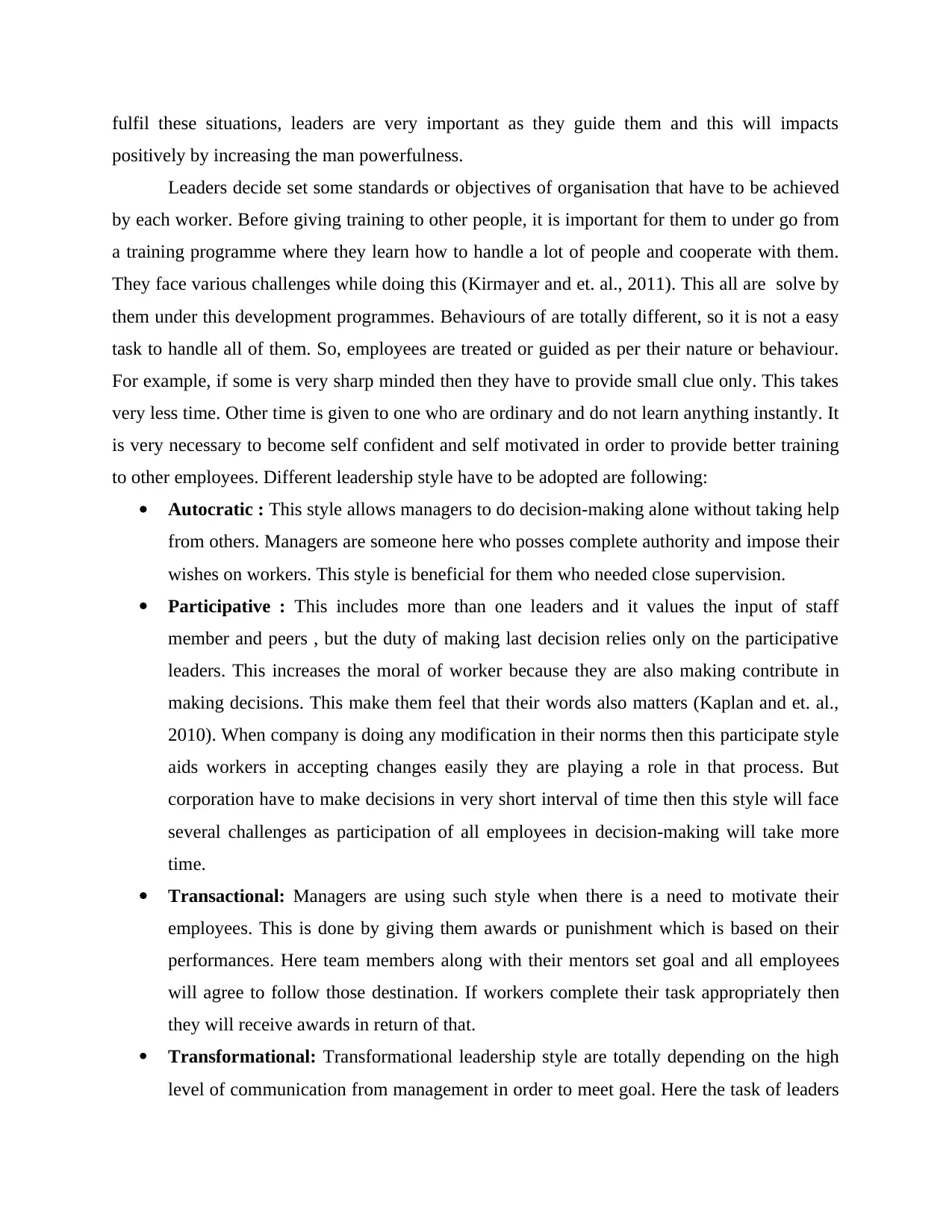
fulfil these situations, leaders are very important as they guide them and this will impacts
positively by increasing the man powerfulness.
Leaders decide set some standards or objectives of organisation that have to be achieved
by each worker. Before giving training to other people, it is important for them to under go from
a training programme where they learn how to handle a lot of people and cooperate with them.
They face various challenges while doing this (Kirmayer and et. al., 2011). This all are solve by
them under this development programmes. Behaviours of are totally different, so it is not a easy
task to handle all of them. So, employees are treated or guided as per their nature or behaviour.
For example, if some is very sharp minded then they have to provide small clue only. This takes
very less time. Other time is given to one who are ordinary and do not learn anything instantly. It
is very necessary to become self confident and self motivated in order to provide better training
to other employees. Different leadership style have to be adopted are following:
Autocratic : This style allows managers to do decision-making alone without taking help
from others. Managers are someone here who posses complete authority and impose their
wishes on workers. This style is beneficial for them who needed close supervision.
Participative : This includes more than one leaders and it values the input of staff
member and peers , but the duty of making last decision relies only on the participative
leaders. This increases the moral of worker because they are also making contribute in
making decisions. This make them feel that their words also matters (Kaplan and et. al.,
2010). When company is doing any modification in their norms then this participate style
aids workers in accepting changes easily they are playing a role in that process. But
corporation have to make decisions in very short interval of time then this style will face
several challenges as participation of all employees in decision-making will take more
time.
Transactional: Managers are using such style when there is a need to motivate their
employees. This is done by giving them awards or punishment which is based on their
performances. Here team members along with their mentors set goal and all employees
will agree to follow those destination. If workers complete their task appropriately then
they will receive awards in return of that.
Transformational: Transformational leadership style are totally depending on the high
level of communication from management in order to meet goal. Here the task of leaders
positively by increasing the man powerfulness.
Leaders decide set some standards or objectives of organisation that have to be achieved
by each worker. Before giving training to other people, it is important for them to under go from
a training programme where they learn how to handle a lot of people and cooperate with them.
They face various challenges while doing this (Kirmayer and et. al., 2011). This all are solve by
them under this development programmes. Behaviours of are totally different, so it is not a easy
task to handle all of them. So, employees are treated or guided as per their nature or behaviour.
For example, if some is very sharp minded then they have to provide small clue only. This takes
very less time. Other time is given to one who are ordinary and do not learn anything instantly. It
is very necessary to become self confident and self motivated in order to provide better training
to other employees. Different leadership style have to be adopted are following:
Autocratic : This style allows managers to do decision-making alone without taking help
from others. Managers are someone here who posses complete authority and impose their
wishes on workers. This style is beneficial for them who needed close supervision.
Participative : This includes more than one leaders and it values the input of staff
member and peers , but the duty of making last decision relies only on the participative
leaders. This increases the moral of worker because they are also making contribute in
making decisions. This make them feel that their words also matters (Kaplan and et. al.,
2010). When company is doing any modification in their norms then this participate style
aids workers in accepting changes easily they are playing a role in that process. But
corporation have to make decisions in very short interval of time then this style will face
several challenges as participation of all employees in decision-making will take more
time.
Transactional: Managers are using such style when there is a need to motivate their
employees. This is done by giving them awards or punishment which is based on their
performances. Here team members along with their mentors set goal and all employees
will agree to follow those destination. If workers complete their task appropriately then
they will receive awards in return of that.
Transformational: Transformational leadership style are totally depending on the high
level of communication from management in order to meet goal. Here the task of leaders
Paraphrase This Document
Need a fresh take? Get an instant paraphrase of this document with our AI Paraphraser
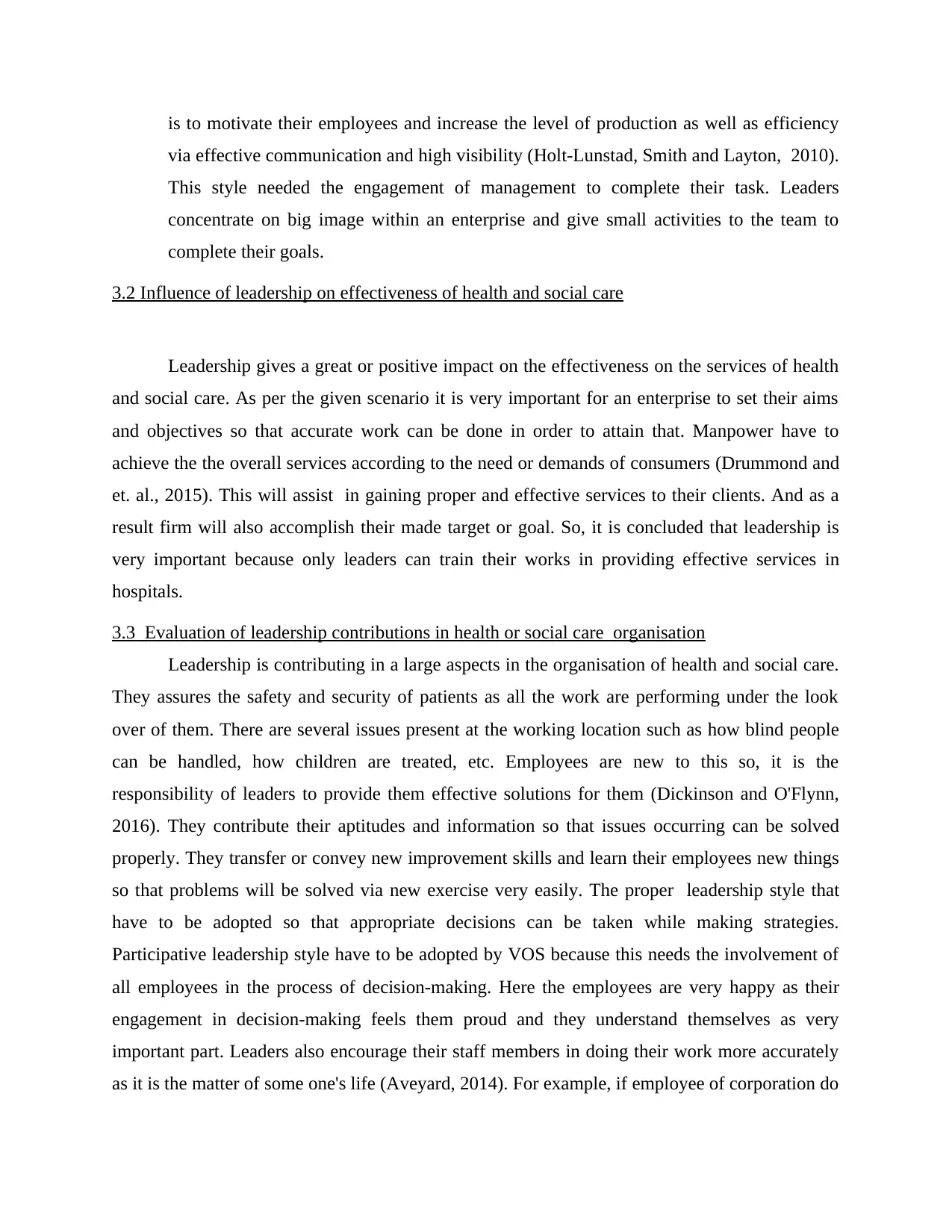
is to motivate their employees and increase the level of production as well as efficiency
via effective communication and high visibility (Holt-Lunstad, Smith and Layton, 2010).
This style needed the engagement of management to complete their task. Leaders
concentrate on big image within an enterprise and give small activities to the team to
complete their goals.
3.2 Influence of leadership on effectiveness of health and social care
Leadership gives a great or positive impact on the effectiveness on the services of health
and social care. As per the given scenario it is very important for an enterprise to set their aims
and objectives so that accurate work can be done in order to attain that. Manpower have to
achieve the the overall services according to the need or demands of consumers (Drummond and
et. al., 2015). This will assist in gaining proper and effective services to their clients. And as a
result firm will also accomplish their made target or goal. So, it is concluded that leadership is
very important because only leaders can train their works in providing effective services in
hospitals.
3.3 Evaluation of leadership contributions in health or social care organisation
Leadership is contributing in a large aspects in the organisation of health and social care.
They assures the safety and security of patients as all the work are performing under the look
over of them. There are several issues present at the working location such as how blind people
can be handled, how children are treated, etc. Employees are new to this so, it is the
responsibility of leaders to provide them effective solutions for them (Dickinson and O'Flynn,
2016). They contribute their aptitudes and information so that issues occurring can be solved
properly. They transfer or convey new improvement skills and learn their employees new things
so that problems will be solved via new exercise very easily. The proper leadership style that
have to be adopted so that appropriate decisions can be taken while making strategies.
Participative leadership style have to be adopted by VOS because this needs the involvement of
all employees in the process of decision-making. Here the employees are very happy as their
engagement in decision-making feels them proud and they understand themselves as very
important part. Leaders also encourage their staff members in doing their work more accurately
as it is the matter of some one's life (Aveyard, 2014). For example, if employee of corporation do
via effective communication and high visibility (Holt-Lunstad, Smith and Layton, 2010).
This style needed the engagement of management to complete their task. Leaders
concentrate on big image within an enterprise and give small activities to the team to
complete their goals.
3.2 Influence of leadership on effectiveness of health and social care
Leadership gives a great or positive impact on the effectiveness on the services of health
and social care. As per the given scenario it is very important for an enterprise to set their aims
and objectives so that accurate work can be done in order to attain that. Manpower have to
achieve the the overall services according to the need or demands of consumers (Drummond and
et. al., 2015). This will assist in gaining proper and effective services to their clients. And as a
result firm will also accomplish their made target or goal. So, it is concluded that leadership is
very important because only leaders can train their works in providing effective services in
hospitals.
3.3 Evaluation of leadership contributions in health or social care organisation
Leadership is contributing in a large aspects in the organisation of health and social care.
They assures the safety and security of patients as all the work are performing under the look
over of them. There are several issues present at the working location such as how blind people
can be handled, how children are treated, etc. Employees are new to this so, it is the
responsibility of leaders to provide them effective solutions for them (Dickinson and O'Flynn,
2016). They contribute their aptitudes and information so that issues occurring can be solved
properly. They transfer or convey new improvement skills and learn their employees new things
so that problems will be solved via new exercise very easily. The proper leadership style that
have to be adopted so that appropriate decisions can be taken while making strategies.
Participative leadership style have to be adopted by VOS because this needs the involvement of
all employees in the process of decision-making. Here the employees are very happy as their
engagement in decision-making feels them proud and they understand themselves as very
important part. Leaders also encourage their staff members in doing their work more accurately
as it is the matter of some one's life (Aveyard, 2014). For example, if employee of corporation do
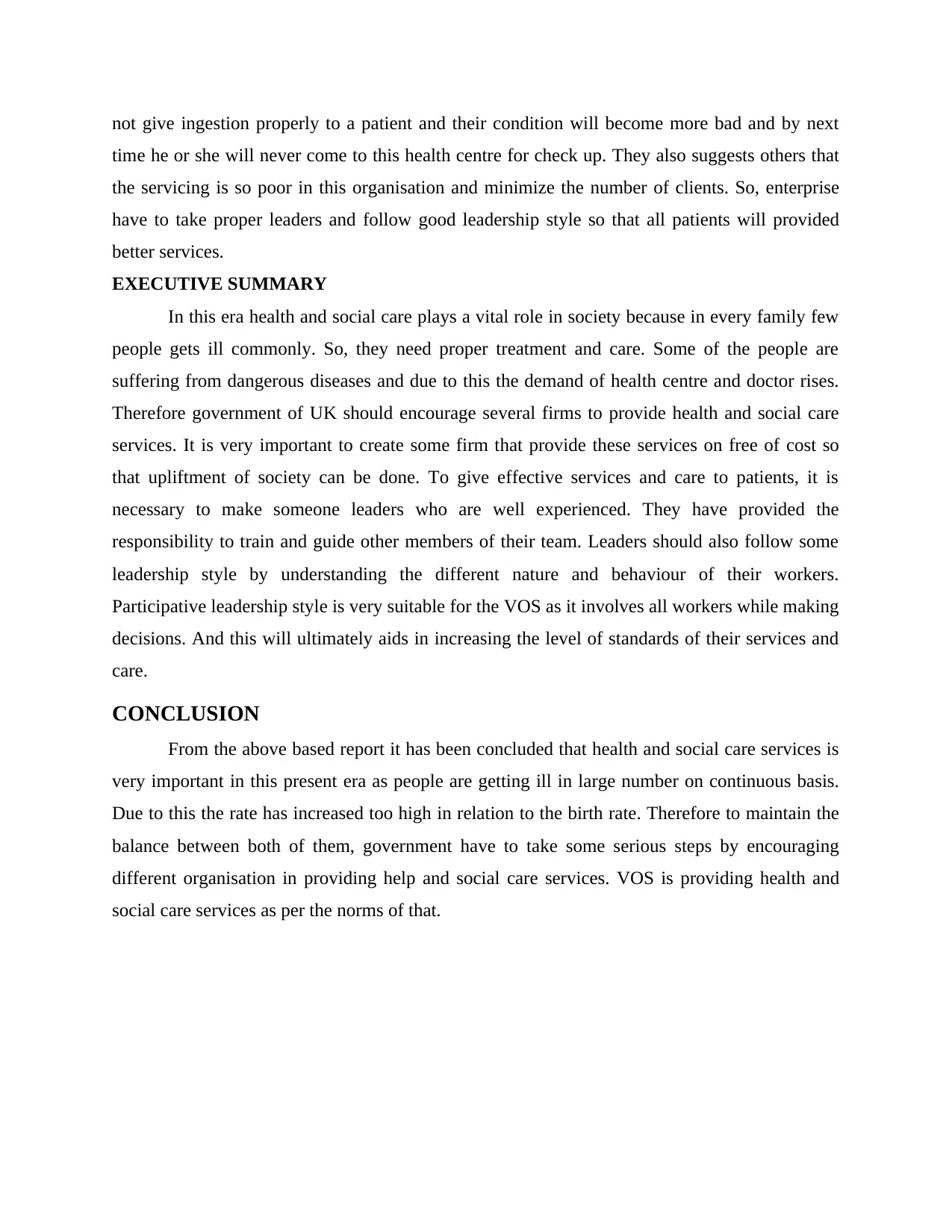
not give ingestion properly to a patient and their condition will become more bad and by next
time he or she will never come to this health centre for check up. They also suggests others that
the servicing is so poor in this organisation and minimize the number of clients. So, enterprise
have to take proper leaders and follow good leadership style so that all patients will provided
better services.
EXECUTIVE SUMMARY
In this era health and social care plays a vital role in society because in every family few
people gets ill commonly. So, they need proper treatment and care. Some of the people are
suffering from dangerous diseases and due to this the demand of health centre and doctor rises.
Therefore government of UK should encourage several firms to provide health and social care
services. It is very important to create some firm that provide these services on free of cost so
that upliftment of society can be done. To give effective services and care to patients, it is
necessary to make someone leaders who are well experienced. They have provided the
responsibility to train and guide other members of their team. Leaders should also follow some
leadership style by understanding the different nature and behaviour of their workers.
Participative leadership style is very suitable for the VOS as it involves all workers while making
decisions. And this will ultimately aids in increasing the level of standards of their services and
care.
CONCLUSION
From the above based report it has been concluded that health and social care services is
very important in this present era as people are getting ill in large number on continuous basis.
Due to this the rate has increased too high in relation to the birth rate. Therefore to maintain the
balance between both of them, government have to take some serious steps by encouraging
different organisation in providing help and social care services. VOS is providing health and
social care services as per the norms of that.
time he or she will never come to this health centre for check up. They also suggests others that
the servicing is so poor in this organisation and minimize the number of clients. So, enterprise
have to take proper leaders and follow good leadership style so that all patients will provided
better services.
EXECUTIVE SUMMARY
In this era health and social care plays a vital role in society because in every family few
people gets ill commonly. So, they need proper treatment and care. Some of the people are
suffering from dangerous diseases and due to this the demand of health centre and doctor rises.
Therefore government of UK should encourage several firms to provide health and social care
services. It is very important to create some firm that provide these services on free of cost so
that upliftment of society can be done. To give effective services and care to patients, it is
necessary to make someone leaders who are well experienced. They have provided the
responsibility to train and guide other members of their team. Leaders should also follow some
leadership style by understanding the different nature and behaviour of their workers.
Participative leadership style is very suitable for the VOS as it involves all workers while making
decisions. And this will ultimately aids in increasing the level of standards of their services and
care.
CONCLUSION
From the above based report it has been concluded that health and social care services is
very important in this present era as people are getting ill in large number on continuous basis.
Due to this the rate has increased too high in relation to the birth rate. Therefore to maintain the
balance between both of them, government have to take some serious steps by encouraging
different organisation in providing help and social care services. VOS is providing health and
social care services as per the norms of that.
⊘ This is a preview!⊘
Do you want full access?
Subscribe today to unlock all pages.

Trusted by 1+ million students worldwide
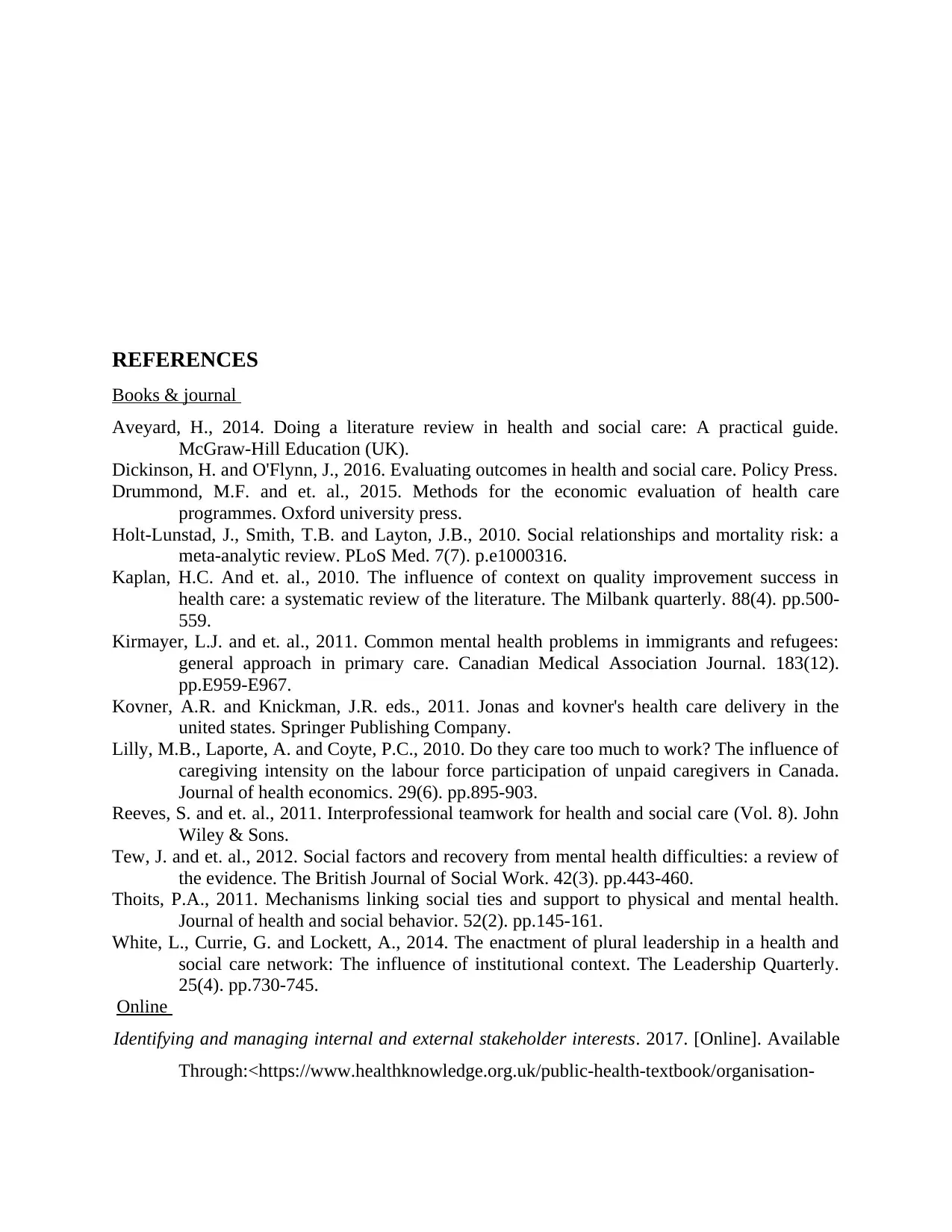
REFERENCES
Books & journal
Aveyard, H., 2014. Doing a literature review in health and social care: A practical guide.
McGraw-Hill Education (UK).
Dickinson, H. and O'Flynn, J., 2016. Evaluating outcomes in health and social care. Policy Press.
Drummond, M.F. and et. al., 2015. Methods for the economic evaluation of health care
programmes. Oxford university press.
Holt-Lunstad, J., Smith, T.B. and Layton, J.B., 2010. Social relationships and mortality risk: a
meta-analytic review. PLoS Med. 7(7). p.e1000316.
Kaplan, H.C. And et. al., 2010. The influence of context on quality improvement success in
health care: a systematic review of the literature. The Milbank quarterly. 88(4). pp.500-
559.
Kirmayer, L.J. and et. al., 2011. Common mental health problems in immigrants and refugees:
general approach in primary care. Canadian Medical Association Journal. 183(12).
pp.E959-E967.
Kovner, A.R. and Knickman, J.R. eds., 2011. Jonas and kovner's health care delivery in the
united states. Springer Publishing Company.
Lilly, M.B., Laporte, A. and Coyte, P.C., 2010. Do they care too much to work? The influence of
caregiving intensity on the labour force participation of unpaid caregivers in Canada.
Journal of health economics. 29(6). pp.895-903.
Reeves, S. and et. al., 2011. Interprofessional teamwork for health and social care (Vol. 8). John
Wiley & Sons.
Tew, J. and et. al., 2012. Social factors and recovery from mental health difficulties: a review of
the evidence. The British Journal of Social Work. 42(3). pp.443-460.
Thoits, P.A., 2011. Mechanisms linking social ties and support to physical and mental health.
Journal of health and social behavior. 52(2). pp.145-161.
White, L., Currie, G. and Lockett, A., 2014. The enactment of plural leadership in a health and
social care network: The influence of institutional context. The Leadership Quarterly.
25(4). pp.730-745.
Online
Identifying and managing internal and external stakeholder interests. 2017. [Online]. Available
Through:<https://www.healthknowledge.org.uk/public-health-textbook/organisation-
Books & journal
Aveyard, H., 2014. Doing a literature review in health and social care: A practical guide.
McGraw-Hill Education (UK).
Dickinson, H. and O'Flynn, J., 2016. Evaluating outcomes in health and social care. Policy Press.
Drummond, M.F. and et. al., 2015. Methods for the economic evaluation of health care
programmes. Oxford university press.
Holt-Lunstad, J., Smith, T.B. and Layton, J.B., 2010. Social relationships and mortality risk: a
meta-analytic review. PLoS Med. 7(7). p.e1000316.
Kaplan, H.C. And et. al., 2010. The influence of context on quality improvement success in
health care: a systematic review of the literature. The Milbank quarterly. 88(4). pp.500-
559.
Kirmayer, L.J. and et. al., 2011. Common mental health problems in immigrants and refugees:
general approach in primary care. Canadian Medical Association Journal. 183(12).
pp.E959-E967.
Kovner, A.R. and Knickman, J.R. eds., 2011. Jonas and kovner's health care delivery in the
united states. Springer Publishing Company.
Lilly, M.B., Laporte, A. and Coyte, P.C., 2010. Do they care too much to work? The influence of
caregiving intensity on the labour force participation of unpaid caregivers in Canada.
Journal of health economics. 29(6). pp.895-903.
Reeves, S. and et. al., 2011. Interprofessional teamwork for health and social care (Vol. 8). John
Wiley & Sons.
Tew, J. and et. al., 2012. Social factors and recovery from mental health difficulties: a review of
the evidence. The British Journal of Social Work. 42(3). pp.443-460.
Thoits, P.A., 2011. Mechanisms linking social ties and support to physical and mental health.
Journal of health and social behavior. 52(2). pp.145-161.
White, L., Currie, G. and Lockett, A., 2014. The enactment of plural leadership in a health and
social care network: The influence of institutional context. The Leadership Quarterly.
25(4). pp.730-745.
Online
Identifying and managing internal and external stakeholder interests. 2017. [Online]. Available
Through:<https://www.healthknowledge.org.uk/public-health-textbook/organisation-
Paraphrase This Document
Need a fresh take? Get an instant paraphrase of this document with our AI Paraphraser
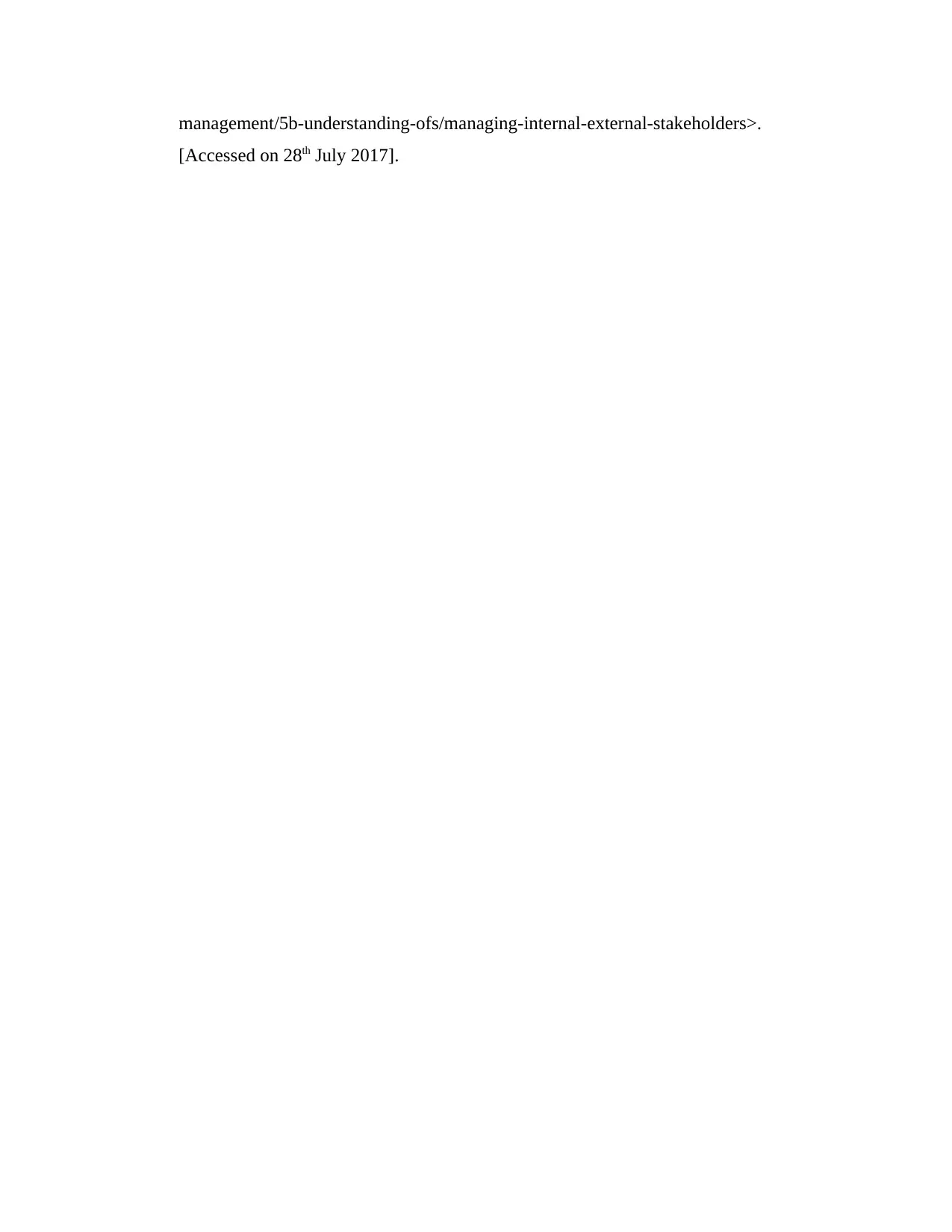
management/5b-understanding-ofs/managing-internal-external-stakeholders>.
[Accessed on 28th July 2017].
[Accessed on 28th July 2017].
1 out of 11
Related Documents
Your All-in-One AI-Powered Toolkit for Academic Success.
+13062052269
info@desklib.com
Available 24*7 on WhatsApp / Email
![[object Object]](/_next/static/media/star-bottom.7253800d.svg)
Unlock your academic potential
Copyright © 2020–2025 A2Z Services. All Rights Reserved. Developed and managed by ZUCOL.





